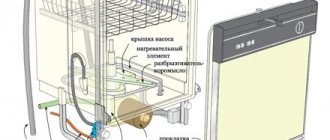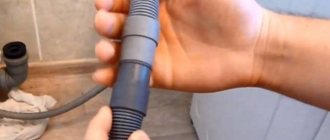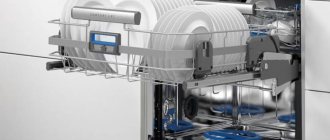Even reliable household appliances sometimes cease to provide impeccable performance. Similar problems include the following: the dishwasher does not drain water, the dishwashing process is interrupted. It seems that nothing foreshadowed trouble. In fact, the main reason for such a breakdown is improper care of the kitchen assistant.
There is water at the bottom of the dishwasher chamber, the drain does not work
In such a situation, you can dial the phone number of the service center and call a technician. But in most cases, owners of a dishwasher (hereinafter also referred to as PMM, dishwasher) can fix such a malfunction on their own.
Basic rules of care
When operating this household appliance, adhere to the following rules:
- To ensure that your dishwasher serves you for a long time, check the water inlet hoses frequently. If necessary, clean them with a toothpick.
- Dry the rubber gasket in the door once every 2 months.
- Before washing, be sure to clean the dishes from food residues. Try not to overload the car.
- To keep your dishes sparkling clean, choose the right dishwasher cleaner. Check that the glitter and salt compartments are well filled.
To make cleaning your dishwasher easy and to prevent damage, please note that the following dishes cannot be washed in it:
- cutlery made of wood (partially or completely), since they lose their presentation, and the glue used in the manufacture of such utensils does not withstand high temperatures;
- decorative glass products that are very sensitive to external influences;
- rare porcelain or antique dishes of special manufacture;
- disposable plastic tableware;
- crystal with lead particles;
- products made from synthetic materials sensitive to high temperatures;
- copper and tin utensils;
- stainless steel items;
- articles of applied art;
- old dishes whose coating is not heat-resistant;
- products with silver and gold inserts, since when washed, the color may change and the dishes may fade.
How to remove scale, grease and blockages using traditional methods
One day a customer came to our electronics store who bought a dishwasher from us about six months ago. She threw a real scandal, saying that we sold her defective equipment, which so quickly began to function poorly. To help you understand the situation, dirt is no longer completely removed from the dishes.
The lady began to demand the return of money for the goods or payment for the repair of a broken car. Then I had to ask the customer a counter question: how often did you clean such an expensive device, did you use special products, and how often did you use them? The answer simply infuriated me. She said she often used the tablets to clean dishes and the dishwasher.
That is, in six months of operation the hose, drain or filter has never been cleaned. Then I had to remind the woman once again about the frequency of “hygiene” of equipment and talk about an effective folk remedy against scale, which every housewife can find in her kitchen. You can effectively clean scale at home with citric acid. To do this, you will need 200-400 grams of acid, which needs to be poured into the dishwasher, after which you need to start the normal dishwashing mode. Just a few days later, the customer came with words of apology and thanked her for the useful advice.
If you don’t want to find yourself in the same awkward situations, then you should pay more attention to technology and take note of several popular methods for cleaning your dishwasher from scale, grease and clogs.
- As you already understood, the first remedy is citric acid. It perfectly removes scale, blockages in the drain and greasy build-ups on important elements. The only rule when using such a “hot” product is to rinse the device again using the normal washing mode to completely remove any remaining lemon juice.
- The second option is lemon juice. In order to get rid of fat on the door and rubber bands, just squeeze out the juice of 3 fruits and wipe the indicated elements with it, then wipe them dry.
- Another effective remedy for scale and blockages is vinegar. To clean with vinegar, you will need to pour 400 ml of the product into the bottom of the basket, turn on the unit to heat the water, start the device and stop it approximately halfway through the cycle. If the blockage is minor, you can continue the washing process after 30 minutes. If you need to get rid of a more serious blockage, then leave the machine in this state overnight and finish the cycle in the morning.
- A riskier method is bleach. If the internal parts of your dishwasher are made of stainless steel, then you will have to abandon this product immediately. If not, know that bleach is a great way to combat mold. To do this, you need to pour 200 ml of the solution into the dishwasher and run a full wash cycle at high temperature.
Don’t forget about preventing the occurrence of fat deposits, unpleasant odors, and scale. “Fairy”, “Fairy Platinum” (soda tablets), “Antinakin” or “Finish” for dishwashers can help you with this.
Remember that poor performance or breakdown of equipment is often caused by improper care. Hopefully, after reading this article, you will become more diligent about taking care of your dishwasher and can affordably clean it yourself. By the way, don’t forget about your other friends from the world of technology, for example. Subscribe to updates, invite friends and always be the first to know the news of the technology world.
Prevention
To avoid breakdowns, both for people and machines, the best way is prevention. Let's take a closer look at how preventing dishwashers from clogging will help you avoid unnecessary costs:
- Clean the internal filter weekly; to do this, remove it from the machine, clean it of food residues and rinse it under running water. Or if the filter suddenly becomes very clogged, soak it in a solution of vinegar or dishwasher detergent for a while.
The machine blades must be unscrewed and removed from the machine. Check how water flows through them; if there is a blockage, it must be removed using a thin wire or toothpick. The most important thing is that water passes through all the holes in the wash shower blades without any problems, otherwise your machine will consume more water than it should, and the quality of washing dishes will be poor. Having put the blades in place, check whether they rotate easily; if not, then it is necessary to clean the axis of the resulting contamination;
- Every six months it is necessary to check and remove blockages in the water drainage system, as well as its supply. Remove the filters at the ends of the hoses and wash them in running water. If you see that they are too worn out, replace them with new ones.
Monitor the operation of the drain pump and regularly check it for blockages from all kinds of solid particles. Checking will save you from serious problems and reduce the likelihood of pump failure, and will save you from completely replacing it, which can cost a pretty penny;
- Every day, in order for your assistant to serve for a long time and please you, you must follow some rules. Don't accumulate large amounts of dirty dishes, this will save you from wasting a lot of water and protect your machine from excess food residues that lead to clogs.
Periodically, you can turn on the machine in economy mode without dishes - this will help remove excess food remaining in the machine. Also, to prevent blockages, you can pour two glasses of vinegar into the machine and run it in economical mode, and in the middle of the cycle, stop and let it stand with the solution for 15-20 minutes, and if you think that there is a lot of dirt, then you can leave it and at night. Then turn it on and let it finish the cycle. This procedure will clean the dishwasher parts and dissolve any blockages, if any.
As mentioned, the best cure for dishwasher clogs is to prevent them. Take care of your equipment and it will definitely serve you for a long time.
Source: aqua-sovet.ru
How to clean parts and remove blockages
To solve sewer problems, you can call a repairman or do it yourself. For example:
- clean the contaminated area with a thin brush on a wire;
- disconnect the siphon and rinse it with water;
- add special powder and use a plunger.
What to choose is up to you. You also need to clean the drain hose: under pressure from a tap or mechanically (using a brush).
You will have to devote more time to internal problems. Let's look at how to clean a clogged filter.
Drain filter
Before starting work, disconnect the PMM from the network and turn off the water supply. Proceed like this:
- Open the camera door.
- Pull out the lower dish basket.
- Unscrew the filter and metal mesh from the pan.
- Rinse under the tap. Additionally, you can use a soft brush and toothpick for particularly difficult stains.
Remove water from the container in the tray with a sponge. Remove the pump damper. Pull the cover to the side and then towards you. Additionally, you may need to unscrew the screws. Check the impeller for blockages. If everything is in order, then inspect the pump and its parts.
Drain pump
You need to disassemble the dishwasher to get to the pump. Remove all baskets from the chamber. Pull the car out into a free space and place it “on its back”. Then do this:
Unscrew the screws or unfasten the latches of the bottom cover (bottom). A float sensor can be attached to the back of the bottom. Carefully unscrew the mounting bolt and unfasten the wiring. Once you gain access to the circulation block, you will notice that the pump is attached to the side. Unscrew its screw. Disconnect the wiring plugs.
Additionally, you can inspect other parts, hoses, and pipes.
Spray
Everything is simple here:
- The lower rocker arm is located near the drain filter.
- Scroll it and remove it from its seat. On some models, you may need to press down on the latches.
- Rinse the part with water. Additionally, the injectors are cleaned with a toothpick.
Be sure to inspect the top sprayer and its openings. Sometimes scale accumulates in the holders to which the sprinkler is attached.
Intake filter
The mesh can be cleaned by disconnecting the inlet hose from the PMM body. If a part is clogged with scale, place it temporarily in water with the addition of citric acid. It is recommended to clean the mesh at least once every six months.
Types of blockages and reasons for their occurrence
If the PMM does not drain or does not fill with water, the reason may be a blockage. Depending on the brand of dishwasher - Bosch, Siemens, Ariston, Indesit, Veko - an error code may appear on the display. Deciphering the code indicates a problem that needs to be found and fixed.
If no error appears on the display, you will have to look for the cause of the problem on your own. First you need to determine the type of blockage: external or internal.
External factors:
- The sewer system, pipes, or the connection between the drain hose and the sewer system are clogged.
- The siphon is clogged (when connected through it). If the siphon is poorly permeable, it is difficult for water to drain out of the sink. This may serve as an additional sign for verification.
- The drain hose was bent and twisted. This happens when the connection is incorrect. The hose may be crushed by a foreign object.
What to do in this case? Check that the drain system is connected correctly. Turn off the water supply, disconnect and install the hose correctly, without kinks. Also disconnect its end from the sewer and clear the blockage with special means. Don't forget to check and clean the siphon.
Hair Ball Clog in Drain Pipe
Internal blockage appears if you did not properly clean the dishes before loading them into the chamber. Pieces of food, parts of napkins, and toothpicks flow into the tray along with the water. If dishes break during washing, then fragments also penetrate into the filter and drain.
What parts can become clogged with debris:
- Drain filter. It serves as a barrier behind which the pump impeller and the pump itself are hidden. The water passes through the filter so that the water goes down the drain or begins to circulate through the chamber again. Therefore, it is recommended to clean it twice a month. Better yet, check the filter after every wash.
- Spray. Water is supplied by a circulation pump to the sprinkler, from where it flies out of the nozzles (holes) under pressure. The nozzles become clogged - no water flows, the system generates an error or stops working.
- The drain is clogged. If the filter fails, food debris penetrates further into the pump and drain hose. To remove foreign objects, you will need an article on how to disassemble a dishwasher. We will also describe the sequence of work in this publication.
- Inlet filter. At the inlet to the fill valve there is a fine mesh that stops large particles of debris from the water supply and rust. Over time, the part becomes clogged and needs to be cleaned.
How to clean the dishwasher filter if it is clogged
It often happens that dishwasher filters become dirty. This significantly complicates the operation of the device and reduces the quality of washing. If the blockage is not cleared in a timely manner, it may lead to damage to the device. Cleaning your dishwasher filter periodically will help avoid many problems.
How to clean the filter?
Causes of filter clogging
The main reason is large food residues on the dishes. Before loading dishes, you should thoroughly clean the plates from any remaining food and be sure to rinse them with warm running water.
But even this event will not completely eliminate the possible clogging of the filter, because fat accumulates on it, which does not completely dissolve in water. Detergent residue can also cause clogs. Scale and plaque also leave their mark on the surface of this element.
How to remove the filter
In household Bosch or Electrolux dishwashers, the filters are located in the lower internal part of the device, above them there are rocker arms for distributing water and a heating element. The structure of a Bosch dishwasher is shown in the photo.
Before removing the filter for cleaning, you should unplug the device from the power supply, then use a sponge or rag to collect excess water. Only then can you remove the filter itself. By the way, the remaining parts - water distributors, heating element - should also be cleaned of scale and other contaminants.
It is very easy to understand that the filter is clogged and requires immediate cleaning. The machine begins to work much worse than before. The quality of dishwashing decreases, the appliance begins to make some noise, and water remains at the bottom. All this indicates that it is time to urgently clean the filter.
How can you clean the filter?
There are several available ways to clean the filter in your dishwasher:
- Using dishwashing detergent and cleaning powder. They can be applied using an old toothbrush, then rinse thoroughly with running water, and the procedure can be repeated if necessary.
- Another effective remedy that will help get rid of fat is baking soda. It can be used along with table salt, which also helps clear grease stains. But it’s better to dilute the powder with water and apply the slurry with a dishwashing sponge, then rinse.
- The last method, which will help not only get rid of fat, but also limescale, is citric acid; for this, the part should be soaked in the solution for several hours, then washed with soapy water. Vinegar works in a similar way. If there is no citric acid, it will completely replace it.
It often happens that the filter located on the water supply valve becomes clogged. You should not forget about cleaning it, even if not too often.
The water that passes through it every day is not of high quality. It may contain a lot of salts or lime. Sometimes rust particles come out of the pipes.
If the dishwasher filter is not cleaned on time, the water will draw in much more slowly.
Preventive measures
A few simple rules will help avoid many problems:
- All food residues should be removed from dishes before loading them into the machine. It is advisable to rinse it with warm water to partially remove the grease.
- To wash dishes, you must use special liquids, powders or tablets; A household product will not work.
- It is advisable to use special water softeners - this will reduce the accumulation of scale on the heating element and water distributors.
- The filter must be removed and washed at least once every two weeks. And once every three months you should carry out a general cleaning inside the device, because dirt and grease accumulate throughout the entire internal surface of the machine, which causes an unpleasant odor and the formation of fungus.
It is advisable to clean the dishwasher filter and clean the inside of the appliance as often as possible. Anyone can do this on their own.
All these measures significantly extend the life of the equipment and help avoid the need for expensive replacement of some parts and components.
In the video you can see detailed instructions for cleaning the dishwasher filter from clogging.
Causes of internal problems
Internal clogs in a dishwasher occur for various reasons, and there are many more of them than external ones. Let's take a closer look at what can clog the dishwasher.
Dishwasher filter clogged
- Internal filter clogged. The operating instructions for your dishwasher recommend that before placing dishes in the dishwasher, remove any food residue from them. Often ignoring this simple advice, you can cause yourself a lot of problems. The machine may stop at the most inopportune moment due to the internal filter becoming clogged with food debris or pieces of napkins;
- The water drainage system in the dishwasher is clogged. Residues of food or pieces of napkins left on the plates may clog the drain hose. Small particles, penetrating through the filters, clog the hose itself, creating blockages in it, and this, in turn, prevents the machine from working normally, which can lead to serious damage;
- water supply valve filter clogged. The water supplied to apartments is not always of the required quality. Increased hardness and salts contained in the water can affect the operation of the inlet valve and clog the inlet filter. Sometimes turning off the water frequently can lead to clogging. Due to air entering the system, the filter may become clogged with rust particles located in the pipes;
- drain pump clogged. Possible due to small fragments from broken dishes or solid food residues in the form of bones or unnoticed toothpicks getting directly into the pump itself;
Dishwasher blades clogged
Getting rid of limescale
When caring for your machine, you need to decide not only how to clean it from grease, but also how to get rid of scale.
. The heating elements are inaccessible for direct contact; disassembling the machine to gain access to them from the inside is strictly not recommended. Scale can only be dealt with using chemicals. The products can be either specialized, purchased in a store, or “homemade,” that is, from improvised ingredients.
Professional anti-scale products
To remove scale, acid-based products are used, which, by triggering a chemical reaction, destroy the plaque on the heating elements.
The most popular dishwasher detergents are “Fairy” and “Finish”
.
- “Fairy” (or “Fairy Platinum”) is available in the form of a gel or tablets with inclusions that prevent the appearance of scale and the spread of rust.
- “Finish” is a gel-like preparation produced in 250 ml bottles. The container with the product should be placed in the dishwasher and run a cycle with a water temperature of 60−70°C.
Both products have already received many rave reviews from dishwasher owners.
Many people complain about the poor quality of various tablets: the dishes are not washed, smudges remain, and the product itself remains on the plates and cups. But Fairy capsules do a great job: in 40 minutes they perfectly wash simple dishes, frying pans, and frying pans with grease build-up.
Irina, 32 years old.
I like Fairy All in 1: these are capsules with powder and gel. The white powder is the actual detergent, and the gel is a rinse and water softener. After them, the dishwasher shines, and there is no need for special cleaning.
Sofia, 35 years old.
I have a Bosch dishwasher, which after three years has become terrible at cleaning dishes. I bought Finish and followed the instructions: I removed all the dishes, removed the sticker, turned them upside down and placed them at the very bottom. The cycle started as long as possible, with a temperature of 65 degrees. When the cycle ended, the machine smelled pleasantly of lemon, and the dishes now clean perfectly again!
Nastya, 28 years old.
Remedies for plaque from scrap materials
The price of professional anti-plaque products seems exorbitant to some.
. Thrifty housewives can resort to home remedies that will effectively help clean the dishwasher.
Choosing a specific cleaning product is the right of every housewife. The main thing is not to neglect the rules of caring for equipment and not to ignore symptoms indicating contamination:
- A louder pump sound indicates that the filter is dirty.
- Poorly washed dishes indicate the presence of blockages and deposits on the baskets and blades.
- An unpleasant smell, red and black spots on the door are a sign that grease has reached the secluded corners, the seals are overgrown with dirt, and the machine itself needs to be dried more often.
Grease, dirt and residue make the dishwasher ineffective. Take care of it carefully, and then the equipment will last a long time.
Attention, TODAY only!
Good afternoon, dear readers. Quite often I have to deal with such a problem as customer complaints regarding malfunctions in dishwashers. Often, excited and angry people come to the store to return goods because they were allegedly sold a low-quality product, without even realizing that they themselves have become a “stumbling block” for expensive equipment
The reason for this may be improper care, which is why it is so important to know how to clean a dishwasher at home, which will be discussed in today’s article
How to effectively care for your equipment
Before you clean your dishwasher, you should understand its structure. First of all, it is disassembled into several components, since the heating element, blades and body are separately descaled. For each part, effective products are used that do not harm the material.
Cleaning the case
Even the external parts of the dishwasher get dirty: dust, grease and food particles. When cleaning the housing, the following recommendations are taken into account:
- cleaning is carried out using a glass cleaner that copes well with dirt and does not harm the control panel;
- glass cleaners are equipped with a sprayer, so the product is evenly distributed over the surface, and then the body is wiped with a dry cloth to prevent streaks;
- If there is heavy dirt and grease deposits, you can clean the housing with a sponge and dishwashing detergent. It is not allowed to pour a lot of water onto the surface. At the end of the procedure, the product is wiped dry;
- Do not use any caustic chemicals or hard brushes, as this will cause unsightly scratches and abrasions on the surface.
If you do not pay attention to proper cleaning, the dishwasher will not only look ugly, but will also cease to cope with its responsibility.
Cleaning the heating element
Scale constantly appears on this element due to the use of hard water. It can be cleaned by chemical means or mechanical action. In some models of equipment, the heating element is pulled out, so washing it is very simple.
The following methods are used for this:
- Among the commercial preparations, Calgon stands out, removing plaque and preventing its formation;
- if there are heavy deposits, you will have to use mechanical cleaning, which involves using a spatula, metal brushes or other similar tools;
- small plaque can be removed with citric acid, but its concentration should be in the range from 4 to 10%;
- vinegar is used if you can remove the heating element from the machine. It is immersed in water mixed with acetic acid.
The heating element must be cleaned at least twice a year. The number of cleanings increases with rapid scale formation. Such actions can increase the service life and increase the efficiency of equipment.
Simultaneous cleaning of blades and seals
Each dishwasher has special blades, represented by an impeller and rocker arms. They circulate water in the equipment, so they periodically become dirty. They become clogged with food debris, and scale from hard water also forms. The same applies to seals and filters.
Therefore, cleansing consists of the following actions:
- the blades are removed from the equipment and thoroughly washed with dishwashing liquid;
- small holes are cleaned with a toothpick;
- filters are replaced or cleaned;
- seals are cleaned once every six months, for which products issued for PMM are used;
- the holes between the gaskets are cleaned with an old toothbrush.
Folk remedies
Soda
Baking soda removes old stains and eliminates unpleasant odors. You need to pour soda into the tray of the machine, then turn it on at the highest temperature for a short time.
Vinegar
Effectively disinfects equipment and removes dirt and grease. To do this: fill a plate with vinegar (preferably use distilled white vinegar) and place it on the top shelf. Turn on the device at maximum power. After work, leave the door open to eliminate the unpleasant odor.
Lemon acid
Will help in the fight against scale. Pour 300 g of acid into the machine and run it at full power.
To keep your kitchen appliances in working order, you need to know how to clean a dishwasher at home. The answer to the question must be found in the operating instructions for the device. The manufacturer lists the detergents and cleaning products that are allowed. Budget models, unlike automatic ones, are subject to exclusively manual cleaning. At the same time, you need to remember that you should not rely entirely on automation.
During the first month of operation, the inner surface of the device is covered with a layer of fat. If you do not clean it promptly, then after a few weeks you will need to contact a service center. In most cases, maintenance is performed using a limited list of substances, the use of which inside the unit will not cause harm to it. Unfortunately, not everyone is in a hurry to get acquainted with it. As a result, the number of equipment failures increases.
The first thing the housewife should remember is that you should not use aggressive chemicals and acids. Even if labeled “delicate,” the reagent can still damage the interior surface. The second rule concerns the amount of substance used. Jewelry precision is the key to long-term health of the dishwasher.
The following tips will help you avoid many problems at the stage of practical operation:
- It is recommended to ventilate the unit after each use - this reduces the rate of formation of fatty deposits;
- The thicker the layer of fat inside, the less time you can dry the dishes;
- After completing the sanitary measures, the “insides” of the machine must be dried for at least 40 minutes, otherwise mold will form.
Regularity and consistency are the key to a healthy dishwasher. You can get rid of fat using the recommended list of substances. They are poured into a tank specially designated for this purpose, after which the “cleaning” mode is activated. The main thing is to quickly remove fatty deposits that can harm the mechanical elements of the device.
Breakdowns requiring repair by a specialist
Previously there were problems that you can fix yourself. But often a breakdown can turn out to be more serious than it seems at first glance, and there is no way to do it without outside help.
Pump faulty
Determining whether the circulation pump is working is quite simple: in operating mode it makes a characteristic mechanical sound similar to a hum. Silence or extraneous noise when pumping out liquid is a sign of a breakdown. If you cleaned the pump, ran it in test mode, and it still doesn’t work, then the problem is not a blockage, but a burnt-out motor. There is nothing left to do but replace the entire module. To do this, you will have to disconnect the part from the wiring and disconnect it from the device - it is better to entrust this to a professional.
The water level sensor is faulty
The water level sensor (or pressure switch) may break down, the control board will not be able to adjust the operation of the pump - as a result, the liquid does not leave the pan. The pressure switch is located under the bottom of the machine and is a plastic box connected to a pressure tube. We recommend entrusting repairs or replacements to a professional.
The electronic “brain” burned out
The electronic module or “brain” controls all dishwasher systems. It may fail if water accidentally gets on it or if there is a power surge, which means the machine will stop and the water will not drain. Its breakdown is a serious problem. We need diagnostics of a complex device, which can only be carried out by a trained service employee. The control unit may have to be reflashed or completely replaced, but this is expensive, and most often, it turns out to be more profitable to buy a new dishwasher.
Other mechanical failures
Incomprehensible noise, rattling and grinding can be eliminated with your own hands only if they are caused by fragments of dishes or other hard debris getting into the system, which can be reached. Check the entire path of water flow from start to drainage, remove all excess and start again. If nothing is found, but the knock remains, call a specialist to your home.
Prevention: how to wash a dishwasher
Sanitary procedures will not take much time if you follow some rules
You need to pay attention to the hose responsible for releasing water. Every 2 months it should be cleaned with a soft brush and rinsed
In order to avoid having to literally peel off all sorts of dirt at the end of the month, you should inspect the dishes before each wash. The surface is freed from large and small food residues, otherwise the mechanical parts of the product will quickly fail.
In addition to the tips listed above, there are a number of others:
- Each machine has a maximum weight - an indicator characterizing the dishwasher’s ability to wash a certain amount of dishes. You cannot exceed it even slightly.
- Even the most expensive unit will not be able to wash dishes if the wrong cleaning agent is selected. This must be purchased taking into account the characteristics of the cookware itself, the prevailing types of contamination and the manufacturer’s recommendations.
- Before starting work, you should check the salt sections of the substance responsible for the formation of shine. It is forbidden to turn on the dishwasher if the listed elements are in insufficient quantities.
- The dishwasher needs to be rinsed regularly. This can be done in manual and automatic mode, depending on the model. For example, Bosch machines, located in the middle price segment, can be washed by pressing a few keys. The main thing is to choose a substance for this procedure that is recommended; it is better to refuse, otherwise you may lose warranty service.
Instructions on how to drain the water if necessary
If you are waiting for a technician, we recommend that you forcefully drain the water so as not to bother with it and waste extra time. This process depends on your make and model. Older units have a special ratchet switch that controls the drainage. In newer models, you cannot simply open the hopper door - you need to reset the locking program. Press the start button for a few seconds and the door should open. Then the sequence is like this:
- Disconnect the drainage hose from the device and drain directly into a deep container. You can help by clicking on the “Drain” mode. The path is under slight pressure, but the water may spill out a little;
- We also drain the liquid from the water supply hose;
- The water in the machine can be scooped out or drained by carefully tilting the device over the container.
How to avoid problems
By adhering to the operating rules, you can prevent problems. What do we have to do:
- It is good to clean utensils from food residues.
- Clean your dishwasher regularly.
- Clean the drainage filter twice a month, and the bulk filter once every six months.
- Remove scale from parts. Use special salt.
- Dry the hopper after the wash cycle.
This way you can fix problems with your own hands, as well as prevent their occurrence. A video on the topic will help you:
https://youtube.com/watch?v=YW2X1Reu9K4
• Remove the filter by turning the head counterclockwise upward.
• It is almost non-removable; only the mesh can be removed.
• Rinse the insides of the mesh filter thoroughly with hot water, if necessary, use a brush and detergents.
• Using a sponge or small rag, suck out any remaining water from the filter compartment and inspect it thoroughly for dirt, food scraps or other foreign objects.
• Now let’s check the pump blades; to do this, remove the cover protecting them. There are models where it can be easily removed by pressing it until it clicks and pulling it up, but for me you need to unscrew one screw with a hex head; on some there may be two.
• This is what the pump blade protective cover looks like.
• Check the pump impeller; it should rotate without any snags; remove any remaining food or other debris.
• Reassemble everything in reverse order.
Cleaning bosch dishwasher blades
Since we’ve already taken on the repairs, it’s a good idea to clean the blades at the same time; the holes in them also get clogged with food debris, which need to be cleaned occasionally for the machine to work properly.
We remove the upper blade; to do this, turn the special “lamb” half a turn counterclockwise.
Under the pressure of hot water, we clean the holes with a regular match or toothpick.
The lower blade is held on by four latches, two on each side; carefully unfasten it, pulling it up, clean it and put it in place.
Now it is possible to check the result of the work performed. If you don’t know how to reset the remaining time on your model, then just pour a couple of liters of water and then safely turn on the Bosch dishwasher or any other.
She must pick up the previously started cycle and finish it as expected by draining the water into the sewer, which will be a successfully completed repair with her own hands.
We watch a video about the advantages of a dishwasher, as well as how to load dishes correctly.
«>
Tips for using your dishwasher correctly
Tips for using a dishwasher correctly
When a dishwasher is clogged, not every user will understand how to clean it. To ensure that such a need arises as rarely as possible, take note of the advice of professionals:
- Before placing the dishes in the machine, be sure to wipe them with a napkin to remove large food residues.
- From time to time, check the compartments for detergent compositions and tablets - powder should not accumulate in pieces there.
- Place dishes in baskets correctly: on the lower ones - pots, baking sheets, frying pans, dishes and plates, on the upper ones - mugs and other “trifles” with the bottom up (so that water and detergent do not accumulate). Make sure that these items do not come into contact with each other.
- After each use of the unit, do not forget to wipe its surfaces, door and rubber seals with a soft cloth.
- Add special regenerating salts to dishwashing detergents. You can simply buy tablets with water softening ingredients.
- If you notice dirt, remove it immediately, rather than waiting for it to harden before the general wash.
- Do not forget to rinse the coarse filter after each cycle to remove accumulated debris.
- Once the machine has washed the dishes, leave them to dry with the door open. In more modern models, you can turn on auto drying for the same purposes.
How to eliminate the causes yourself
Each of the breakdown options has its own simple solutions, which you can try to cope with yourself. Before starting repairs, you must carefully read the instructions for the machine and unplug the power cord from the outlet. Then remove the drain hose from the sewer and lower it into a bucket. If liquid suddenly gushed out in a sharp stream, then the most likely cause of the blockage is a clogged sewer or drain. If water still remains in the dishwasher, you need to look for the cause further by first collecting it manually and draining the internal tank.
Kink in the drain hose. During general cleaning of the apartment and direct care of the unit itself, its location may temporarily change. Therefore, the drain hose can bend anywhere and prevent water from flowing freely. You need to carefully inspect it for correct installation and correct the position.
Sometimes the hose becomes clogged with mechanical debris (bones, solid food particles) and loses its capacity. Then you need to disconnect it from the dishwasher and remove it from the connection to the sewer and rinse it under strong water pressure.
Poor water pressure. If there is poor pressure in the city water supply system, then it will enter the device in insufficient quantities and can cause a general malfunction of the electronic module. The wash cycle will not start correctly and the sequence of commands may be incorrect.
Clogged sewer in the apartment. If the device has a common outlet with a sink and water does not drain well from there, then you need to try to eliminate the mechanical blockage using special chemicals such as “Mole” or a cable for cleaning the sewer system. Most often, the root cause of poor water drainage in such cases is pipes clogged with plugs of hair, congealed fat or food debris.
A blockage in the general sewer system in an apartment building or private building will also prevent the direct outflow of water. It’s very simple to understand this - not only the water from the kitchen appliances does not drain, but, in general, everything in the house.
Drain filter clogged. Almost always, users of household appliances neglect manufacturers' recommendations for operation. The device is not properly maintained and this leads to failure. When using a dishwasher, the manufacturer strongly recommends cleaning cutlery from any uneaten food particles before putting it in. Otherwise, they heavily clog the fine mesh of the internal filter and prevent the waste liquid from draining. This problem is quite easy to deal with. You just need to take out the removable filter, clean it under running water and install it back.
Clogged blades most often occur due to poor quality of city water. When it is very hard, the small outlet holes become clogged with limescale and the flow of water goes in the wrong place. It is necessary to remove the blades, clean them with a toothpick, rinse them under a strong stream and insert the impeller back.
Drain pump clogged. When the internal drain is clogged, water sits in the internal tank and does not drain through the drain hose. If all of the above measures do not help, then the cause may be the drain pump. You can find its location by carefully studying the instructions. You should unscrew the protective cover and try to rotate the pump blades with a stick or pencil. When movement is difficult, you should try to remove the foreign object and screw the pump back in.
Decoding the e25 code on the dishwasher display - read more in our article.
Malfunctions that you can fix yourself
You can get rid of stagnant water yourself only in some cases.
Primary filter clogged
The most common and easily remediable cause is a clogged primary filter. If you have a problem with drainage, follow these steps:
- Unplug the machine.
- Open the door.
- Remove dishes and baskets from the dishwasher.
- Unscrew the filter cap located at the bottom of the machine.
- Pull out and wash the filter and mesh with detergent.
- Remove the impeller. Check it for dirt and rinse it.
- Close the pump.
- Reinstall the filter and mesh.
If the problem was a clogged filter, mesh or impeller, cleaning them will eliminate it. Then the machine will work normally.
To avoid having to clean the filter frequently, carefully remove any remaining food from the dishes before each wash. Once every 3 months, run a self-cleaning program with a special dishwasher detergent. This will not only prevent the formation of blockages, but will also extend the life of the equipment.
The drain hose is kinked or clogged
Improper installation of the drain hose is another reason why water sits in the dishwasher. If it is installed at a height of more than 1.5 m from the floor, the pump cannot handle the rise of water to the siphon or the connection point to the sewer. As a result, the drain hose becomes clogged. The same result will occur if the hose is too long (more than 2 m) or pinched.
Important ! These errors can be easily eliminated: it is enough not to exceed the bend of the hose recommended in the instructions, including when rearranging or cleaning, when the equipment moves from its place.
To understand that the cause of stagnation lies in the drain hose, follow these steps:
- Move the dishwasher away from the wall and look for kinks in the hose. If there is, straighten it and check whether the water begins to drain. Make sure that the dishwasher is located at the optimal distance from the wall (at least 30 cm).
- If there are no kinks, check whether the inside of the hose is clogged with food debris, scale or grease. To do this, disconnect the hose, place its end in a deep bowl or bucket prepared in advance and turn on the drain mode. If the water pressure is strong, that is not the problem. If a plug forms in the hose due to low pressure, remove it with thick wire and special cleaning agents. Be careful not to damage the inside of the hose.
Drain system clogged
Be sure to check if the siphon and general sewer are clogged. Severe blockage of these systems can cause water stagnation in the dishwasher.
Important ! For preventative purposes, use special anti-clogging products at least once a month.
Every six months, it is important to check for blockages in the water drain and supply system and remove them in a timely manner.
Contamination of other areas of the drainage system
Another reason for stagnant water is a clogged drainage system. It is checked like a drain hose: a weak stream of water indicates the need for cleaning. To do this, use special chemicals to remove blockages.











